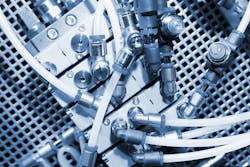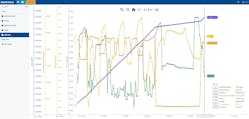Compressed air consumption represents a significant energy cost for many manufacturing plants as pneumatics are used to operate machinery, equipment, tools and more. However, leaks and airflow chokepoints in pneumatic systems drive up costs and reduce productivity continually over time. Exacerbating this problem is that fact that these leaks and chokepoints can be hard to pinpoint.
A brute force approach is to simply keep adding capacity in the form of new air compressors and upsized piping, but this requires large capital and/or operating expenses and it fails to properly address the root cause problems. A better solution is to carefully collect and analyze supply and usage data throughout the system.
Simply installing standard pressure and flow instrumentation is a good start, but these measures are rarely enough on their own to solve the problem. Instead, companies will find an improved approach in strategically installing intelligent air flow monitoring devices with Industrial Internet of Things (IIoT) connectivity coupled with software designed to deliver the insights necessary to guide corrective actions.
Accessing and analyzing data While there are many ways for users to manage or enhance industrial processes, it is commonly understood that the most reliable approaches are data-driven, based on comprehensive measurement and analysis techniques. With the right information and tools, users can identify problems, craft corrective actions and verify results, thereby effecting a proven cycle of continuous improvement.
New installations are more likely to build-in the necessary monitoring and computing provisions—extending beyond basic control—to support such optimization efforts. Retrofitting these capabilities into existing facilities, however, usually presents greater challenges.
To jumpstart energy use and production efficiency improvement initiatives, users are looking for ready-to-go hardware and software, designed to deliver floor-to-cloud connectivity. Some users may try to assemble and custom-configure assorted IIoT sensors, edge gateways and software as they seek results, but this approach can be problematic as it requires significant system integration work.
A better approach is to use a tested portfolio of auto-configured sensors and preconfigured computing hardware and software using industry-standard communication methods. This type of implementation overcomes adoption barriers, reduces risk and deployment timelines, and empowers an organization to start small and then scale up successes.
Applying the right tools Professional tool brands such as Ridgid, Greenlee and Klauke are well known throughout the construction trades. Emerson Professional Tools operates 11 manufacturing locations for these and other brands. The Sissach, Switzerland, plant produces pressing products and accessories, such as battery hydraulic tools and associated jaws and rings. The 45,000-sq.-ft. facility has 80 employees and 24 CNC machines. Production is highly automated, with some equipment operating lights out.
Despite the plant’s high level of automation, the plant team had little information about air consumption needs. As a result, when an extension of shop floor machines was planned, it was assumed that a new air compressor might also be required.
To better understand the real requirements of this extension, an internal project was initiated to monitor and analyze air consumption.
The first step in this project was to install an Emerson Aventics AF2 Series flow rate sensor at 20 of the most significant compressed air usage locations to capture about 70% of compressed air usage. The AF2 is an intelligent flow rate sensor with a local display that can operate over a large range of flows and pressures for a variety of gases.
Standard statistics (mix, max and mean), counting (volume, mass and energy), and logging (with selectable time frames) are integrated onboard the sensor and versions can communicate to host systems using industrial Ethernet protocols—including TCP/IP, OPC UA and MQTT—or via IO-Link or conventional analog signal.
A range of process parameters are monitored and transmitted, such as:
- Volumetric flow rate (L/min — liters per minute)
- Pressure (bar)
- Temperature (°C)
- Mass flow rate (kg/h)
- Flow velocity (m/s)
- Volume (L)
- Mass (kg)
- Energy (kWh)
Because of the flow rate sensor's flexible connectivity options, the integration team was able to leverage existing IT infrastructure and install the sensors rapidly during brief scheduled downtimes. For this application, the flow rate sensors are energized by power over Ethernet (PoE).
Each flow rate sensor includes a built-in web interface, and the sensors also transmit data—using appropriate security credentials—to a preconfigured cloud service, the Compressed Air Manager (CAM). This type of comprehensive solution is scalable up to any number of flow rate sensor.
MQTT is a particularly beneficial protocol for an IIoT project such as this one to communicate field values to an on-premises or cloud-based computer. This enables data to be readily and securely transmitted to a broker for aggregation and storage. The data can also be organized by facility and project.
The CAM application is preconfigured to run on-premises on an edge gateway. Users can extend this to a cloud-based system with the integrated OPC-UA Server, which gives access to the combined data of all connected devices. Standard dashboards are available to provide extensive visualization of an individual flow sensor or of physical or functional groupings of devices, as well as a summary dashboard provides a quick overview. Dashboards are populated automatically as devices are connected into the digital environment and users can choose to dive into deeper analytics as they see fit.
With the sensors physically installed on the network, the team found it only took about one minute per sensor to connect them to the server using the web interface and supplied credentials. The pieces were now in place to begin analyzing the compressed air system.
Plugging leaks with data Initially, the team determined some baseline air demands during the normal production week. This led to the discovery that air demand on weekends still had an unexpectedly high demand, so procedures were put in place to isolate the machines during down times to avoid these losses.
Ongoing deeper dives using the software allowed users to identify any equipment using more air than similar assets, leading the team to identify a series of leakages and other anomalies from large to small, which could then be repaired. In one case, a pressure drop was pinpointed on a machine, which was causing a 5% cycle time decrease. This was rectified by increasing the supply line diameter.
In total, the team identified 850 liters per minute of air lost as leaks, which represented about 20% of the total supply flow. Fixing these problems led to an estimated savings of $58,000 and 68,000 kg of CO2 emission reduction over 10 years. Within five months the team identified savings amounting to 50% payback of the project, with a full payback in less than 24 months.
Furthermore, now that the team had reliable and actionable data on hand, they shifted their efforts away from investing in a new—and unnecessary—air compressor and toward solving leakage issues. They also had data confirming how much the site could be expanded before another air compressor would need to be added.
Complete air management It’s common for industrial facilities of all types to experience up to 30% compressed air waste, not to mention inefficiencies due to machine operation suboptimization. Although these issues run counter to achieving net zero and optimizing both production and overall profitability, most business must manually track down leaks—if they do so at all—incurring considerable labor expenses.
The Sissach factory is a success story for compressed air management and demonstrates Emerson’s commitment to reach net zero within its own operations. Easy-to-install AF2 smart sensors, which are integrated with a CAM application, represent a combined hardware and analytics software digital transformation system that can be rapidly applied at all types of facilities. Sensor auto-configuration and the preconfigured nature of the software reduce installation timelines, risk and other barriers to adoption, leading to a quick ROI and greatly improved operations.
Jan Edler is an IIoT manufacturing applications leader at Emerson’s Discrete Automation business.




